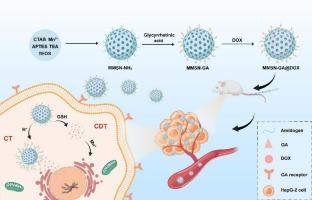Degradable glycyrrhetinic acid functionalized mesoporous silica nanoparticles enhanced liver cancer therapy
IF 4.3
2区 医学
Q1 PHARMACOLOGY & PHARMACY
European Journal of Pharmaceutics and Biopharmaceutics
Pub Date : 2025-09-30
DOI:10.1016/j.ejpb.2025.114880
引用次数: 0
Abstract
The study aimed to design a drug delivery system (DDS) with smart responsiveness in the tumor microenvironment (TME). Herein, manganese-doped mesoporous silica nanoparticles with glycyrrhetinic acid (GA) on their surface (MMSN-GA) were constructed to form a liver-targeted nanocarrier system, which achieved pH/GSH responsive drug release in TME and killed liver cancer cells through the combination of chemotherapy and chemodynamic therapy. The nanocarriers had the advantages of uniform particle size, considerable drug loading efficiency (26.26%), and superior pH/GSH dependency. MMSN-GA exhibited cytocompatibility with HepG-2 cells and high cellular uptake according to MTT and confocal laser scanning microscopy (CLSM) results. Moreover, MMSN-GA@DOX demonstrated excellent antitumor therapeutic effects, and the tumor inhibition rate was 92.32% in tumor-bearing mice. Overall, the MMSN-GA@DOX represents a promising approach for tumor-targeted therapy.

可降解甘草次酸功能化介孔二氧化硅纳米颗粒增强肝癌治疗。
该研究旨在设计一种在肿瘤微环境(TME)中具有智能响应性的药物传递系统(DDS)。本文构建表面带有甘草酸(GA)的锰掺杂介孔二氧化硅纳米颗粒(MMSN-GA),形成肝脏靶向纳米载体体系,在TME中实现pH和GSH响应性药物释放,并通过化疗和化疗动力学联合治疗杀死肝癌细胞。该纳米载体具有粒径均匀、载药效率高(26.26%)、pH/GSH依赖性强等优点。根据MTT和共聚焦激光扫描显微镜(CLSM)结果,MMSN-GA表现出与HepG-2细胞的细胞相容性和高细胞摄取。此外,MMSN-GA@DOX具有良好的抗肿瘤治疗作用,对荷瘤小鼠的肿瘤抑制率为92.32%。总的来说,MMSN-GA@DOX代表了一种很有希望的肿瘤靶向治疗方法。
本文章由计算机程序翻译,如有差异,请以英文原文为准。
求助全文
约1分钟内获得全文
求助全文
来源期刊
CiteScore
8.80
自引率
4.10%
发文量
211
审稿时长
36 days
期刊介绍:
The European Journal of Pharmaceutics and Biopharmaceutics provides a medium for the publication of novel, innovative and hypothesis-driven research from the areas of Pharmaceutics and Biopharmaceutics.
Topics covered include for example:
Design and development of drug delivery systems for pharmaceuticals and biopharmaceuticals (small molecules, proteins, nucleic acids)
Aspects of manufacturing process design
Biomedical aspects of drug product design
Strategies and formulations for controlled drug transport across biological barriers
Physicochemical aspects of drug product development
Novel excipients for drug product design
Drug delivery and controlled release systems for systemic and local applications
Nanomaterials for therapeutic and diagnostic purposes
Advanced therapy medicinal products
Medical devices supporting a distinct pharmacological effect.

 求助内容:
求助内容: 应助结果提醒方式:
应助结果提醒方式:


